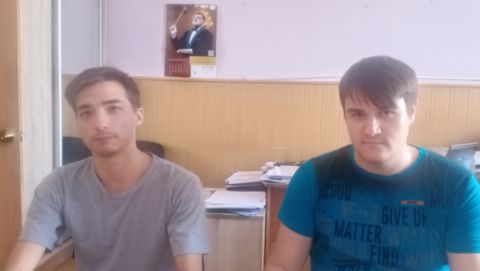Do you know that there is a science called Mechatronics? Combining electronics and mechanics, it helps to build robotic arms ready to work in industry, including conditions difficult for people to operate in. For example, at extreme temperatures or in a chemically aggressive environments.
SUSU students Timur Bakhtimirov and Andrei Iumachikov have recently completed their third academic year of studies. In summer, they also work in a part-time job related to their major − they make training stands using electronics, mechanics, and hydraulics. What is more, we can congratulate the guys on obtaining their first patents for the invention!
Under the guidance of young teachers of the Department of Electric Drive, Mechatronics and Electromechanics Nikita Savostenko and Ivan Kholodilin, Timur and Andrei, jointly with co-authors, created a virtual laboratory for industrial assembly and sorting of parts.
Imagine an assembly line where robots assemble robots. Parts move along the conveyor. One robot sorts them, while the other assembles them. So far, the model designed by students recognizes three types of parts: "head", "arm" (manipulator) and "body". Parts are painted in one of three colours: red, green, or blue.

The robot sees through the eye-camera that the conveyor has given out the next part, turns its head towards it to fix its position. How to set a part so that the computer manages to "see" it? The engineer resorts to SolidWorks and Blender programs. In the first one, he can quite easily create objects of complex shapes and sizes, and in the second one, he can apply a high-poly texture to this object.
And to make the virtual laboratory look like a real one, the young authors used the Unity engine, which is usually used to develop computer games. So, the process can already be seen on the screen as in a game!
Finally, the robot itself with a manipulator: it is not cheap to build it. The students came up with an algorithm that gives commands to the robot's controller. But it is not necessary to make the microcircuit itself − the TIA Portal software package, a microcontroller simulator, is enough. Commands are given to this program.
The work of the sorting robot is more difficult, than that of the assembling robot. The sorting robot needs not only to "see" the part, but also to recognize its shape, and then, using retractable plugs, direct the product further along one of three routes. Here, instead of the Unity gaming platform, Mathlab comes to rescue. Each pixel received from the camera corresponds to six numbers: three coordinates in space, and three intensities of the colour components (red, green and blue). Edges and contours are recognized, the algorithm makes a decision and gives a command to the controller, a virtual one for the moment.
The model is working with parts of a certain shape and with an error of 15% so far: if the part goes too far along the conveyor or looks non-standard, the robot will not notice it. "Actually, parts can be of any shape," Andrei Iumachikov explains. "But for this it would be good to connect artificial intelligence to our model." Who knows, maybe in the future the students will be able to implement this as well.
During excursions at the Chelyabinsk Pipe-Rolling Plant, the guys saw pick-and-place robots of that kind. At the Chelyabinsk Zinc Plant, their groupmates learned to recognize overheating and corrosion of electrodes based on colour tones using a neural network. So, the algorithms, similar to those developed by the Mechatronics students, are in demand at the industrial enterprises of the South Ural region today.




